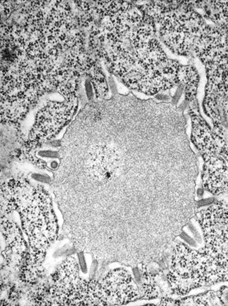Resumo
Definição
História e exame físico
Principais fatores diagnósticos
- presença de fatores de risco
- hidrofobia
- aerofobia
- dormência, dor e parestesia dos membros
- prurido
- disfagia
- febre
- alteração no comportamento
- agitação e confusão
- alucinação
- sinais de instabilidade autonômica
- rápida evolução dos sintomas
- fraqueza e paralisia
Outros fatores diagnósticos
- incontinência urinária ou fecal
- coma
- dor abdominal
- insônia
- convulsões
- fala indistinta ou gagueira
- ataxia
Fatores de risco
- arranhadura ou mordida recente de um vetor conhecido
- visita/residência em países com raiva endêmica
- exposição ocupacional ou recreacional
- idade <15 anos
Investigações diagnósticas
Primeiras investigações a serem solicitadas
- reação em cadeia da polimerase e cultura viral da saliva
- biópsia da pele (pescoço) com teste de anticorpo fluorescente direto (AFD) e reação em cadeia da polimerase
- citologia do líquido cefalorraquidiano (LCR)
- bioquímica do LCR
- anticorpos neutralizantes da raiva no LCR
- imunoglobulina M (IgM) ou G (IgG) sérica da raiva
- reação em cadeia da polimerase para herpes simples no LCR
- reação em cadeia da polimerase para enterovírus no LCR
- imunoglobulina M (IgM) do vírus do Nilo Ocidental no líquido cefalorraquidiano (LCR)
- anticorpos séricos para receptor de glutamato N-metil-D-aspartato (NMDA)
Investigações a serem consideradas
- anticorpos séricos para arbovírus
- anticorpos séricos para Bartonella
- anticorpos séricos para Rickettsia
- ressonância nuclear magnética (RNM) do crânio
Algoritmo de tratamento
assintomático com exposição recente ao vetor
raiva sintomática
Colaboradores
Autores
Sergio Recuenco, MD, MPH, DrPH
Associate Professor
Faculty of Medicine Sa Fernando
National University of San Marcos
Lima
Peru
Declarações
SR declares that he has no competing interests.
Rodney Willoughby, MD
Professor
Pediatrics
Medical College of Wisconsin
Milwaukee
WI
Declarações
RW is an author of a number references cited in this topic.
Agradecimentos
Dr Sergio Recuenco and Dr Rodney Willoughby would like to gratefully acknowledge Dr Kis Robertson, a previous contributor to this topic.
Declarações
KR declares that she has no competing interests.
Revisores
Peter Leggat, MD
Head
School of Public Health
Tropical Medicine and Rehabilitation Sciences
Faculty of Medicine
Health and Molecular Sciences
James Cook University
Townsville
Queensland
Australia
Declarações
PL is a member of the Australian Travel Health Advisory Group that is supported by a grant from GlaxoSmithKline. PL has received travel grants from GlaxoSmithKline to attend travel medical conferences in the last 5 years.
Allan Grill, MD, CCFP, MPH
Assistant Professor
Department of Family and Community Medicine
Dalla Lana School of Public Health
University of Toronto
Toronto
Ontario
Canada
Declarações
AG declares that he has no competing interests.
Créditos aos pareceristas
Os tópicos do BMJ Best Practice são constantemente atualizados, seguindo os desenvolvimentos das evidências e das diretrizes. Os pareceristas aqui listados revisaram o conteúdo pelo menos uma vez durante a história do tópico.
Declarações
As afiliações e declarações dos pareceristas referem--se ao momento da revisão.
Referências
Principais artigos
World Health Organization. Weekly epidemiological record. Rabies vaccines: WHO position paper. April 2018 [internet publication].Texto completo
Centers for Disease Control and Prevention. Use of a modified preexposure prophylaxis vaccination schedule to prevent human rabies: recommendations of the Advisory Committee on Immunization Practices - United States, 2022. May 2022 [internet publication].Texto completo
World Health Organization. WHO expert consultation on rabies: WHO TRS N°1012 (third report). April 2018 [internet publication].Texto completo
Rupprecht CE, Briggs D, Brown CM, et al; Centers for Disease Control and Prevention. Use of a reduced (4-dose) vaccine schedule for postexposure prophylaxis to prevent human rabies: recommendations of the Advisory Committee on Immunization Practices. MMWR Recomm Rep. 2010;59:1-9.Texto completo Resumo
Willoughby RE Jr, Tieves KS, Hoffman GM, et al. Survival after treatment of rabies with induction of coma. N Engl J Med. 2005;352:2508-2514.Texto completo Resumo
Artigos de referência
Uma lista completa das fontes referenciadas neste tópico está disponível para os usuários com acesso total ao BMJ Best Practice.

Diagnósticos diferenciais
- Infecção pelo vírus do herpes simples
- Meningoencefalite por enterovírus
- Encefalite do vírus do Nilo Ocidental
Mais Diagnósticos diferenciaisDiretrizes
- Guidelines on managing rabies post-exposure
- CDC Yellow Book: health information for international travel - rabies
Mais DiretrizesConectar-se ou assinar para acessar todo o BMJ Best Practice
O uso deste conteúdo está sujeito ao nosso aviso legal